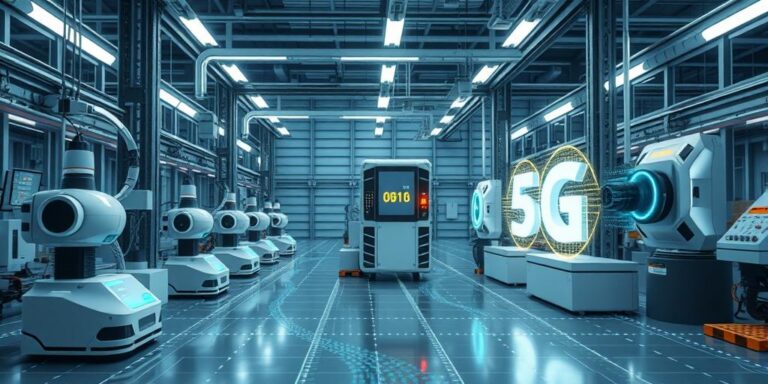The Role of 5G in Powering Real-Time IIoT Applications (2025+)
The Industrial Internet of Things (IIoT) is revolutionizing industries by connecting machines, sensors, and systems to enable data-driven decision-making and automation. However, many IIoT applications require real-time communication and ultra-reliable, low-latency connectivity, which traditional network technologies often struggle to provide. 5G, the fifth generation of wireless technology, is poised to overcome these limitations and unlock the full potential of real-time IIoT applications.
What is 5G, and Why Does it Matter for IIoT?
5G is more than just a faster version of 4G. It’s a fundamentally different network architecture designed to meet the demands of a connected world. Key features of 5G that are particularly relevant to IIoT include:
- Ultra-low latency: 5G can achieve latency as low as 1 millisecond, enabling near real-time communication between devices and systems.
- High bandwidth: 5G offers significantly higher data transfer speeds than 4G, allowing for the transmission of large volumes of data generated by IIoT devices.
- Massive device connectivity: 5G can support a massive number of connected devices per square kilometer, making it ideal for dense industrial environments.
- Network slicing: 5G allows for the creation of virtualized, dedicated networks tailored to specific application requirements, ensuring quality of service (QoS) for critical IIoT applications.
- Enhanced reliability: 5G is designed to be highly reliable, with features such as redundant network paths and advanced error correction mechanisms.
Real-Time IIoT Applications Enabled by 5G
5G’s unique capabilities open up a wide range of real-time IIoT applications across various industries, including:
- Smart Manufacturing:
- Real-time monitoring and control: 5G enables real-time monitoring of production processes, allowing for immediate adjustments to optimize efficiency and prevent defects. Imagine sensors on a factory floor instantly relaying data to a central control system, which then adjusts machinery parameters in real time to maintain optimal performance. This also applies to wireless sensors for industrial IoT.
- Autonomous robots and AGVs: 5G’s low latency and high bandwidth support the operation of autonomous robots and automated guided vehicles (AGVs) in manufacturing facilities, enabling flexible and efficient material handling.
- Predictive maintenance: By analyzing real-time data from sensors on equipment, 5G facilitates predictive maintenance, reducing downtime and improving asset utilization. This allows businesses to forecast when maintenance will be needed on certain machines and schedule downtime accordingly, mitigating losses and maximizing efficiency.
- Smart Grid:
- Real-time grid monitoring and control: 5G enables real-time monitoring of the power grid, allowing for rapid response to fluctuations in demand and supply, as well as improved grid stability.
- Smart metering: 5G supports the deployment of smart meters, providing real-time data on energy consumption, enabling better energy management and demand response.
- Distributed energy resource (DER) management: 5G facilitates the integration of DERs, such as solar and wind power, into the grid, enabling a more sustainable and resilient energy system.
- Connected Healthcare:
- Remote patient monitoring: 5G enables remote patient monitoring, allowing healthcare providers to track patients’ vital signs and provide timely interventions, improving patient outcomes and reducing healthcare costs. This opens doors for more efficient and effective healthcare operations as healthcare providers can keep closer watch on patients from afar.
- Remote surgery: 5G’s low latency supports remote surgery, allowing surgeons to perform operations from a distance, expanding access to specialized medical expertise.
- Real-time medical imaging: 5G enables the transmission of high-resolution medical images in real-time, facilitating faster and more accurate diagnoses.
- Smart Logistics:
- Real-time tracking and monitoring: 5G enables real-time tracking and monitoring of goods throughout the supply chain, improving visibility and reducing losses. With reliable and fast communication, businesses can pinpoint the exact location of their goods and ensure smooth delivery.
- Autonomous vehicles: 5G supports the operation of autonomous vehicles in logistics, enabling efficient and cost-effective transportation of goods.
- Drone delivery: 5G facilitates drone delivery, enabling faster and more convenient delivery of goods, especially in remote areas.
Challenges and Opportunities
While 5G offers tremendous potential for real-time IIoT applications, there are also challenges to overcome:
- Deployment costs: Deploying 5G infrastructure can be expensive, especially in industrial environments. One option is using private 5G networks for industrial sites.
- Security concerns: Connecting industrial devices to the internet increases the risk of cyberattacks. Robust security measures are essential to protect IIoT systems from threats.
- Interoperability issues: Ensuring interoperability between different 5G devices and systems is crucial for seamless integration.
Despite these challenges, the opportunities for 5G in IIoT are immense. As 5G networks become more widely available and affordable, we can expect to see a surge in real-time IIoT applications, transforming industries and driving economic growth.
The Future of IIoT is Real-Time, and it’s Powered by 5G
In conclusion, 5G is a game-changer for the Industrial Internet of Things. Its ultra-low latency, high bandwidth, massive device connectivity, and enhanced reliability make it the ideal technology for powering real-time IIoT applications. As 5G continues to evolve and mature, it will play an increasingly important role in driving innovation and efficiency across industries.




